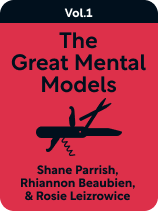

This article is an excerpt from the Shortform book guide to "The Great Mental Models Volume 1" by Shane Parrish and Rhiannon Beaubien. Shortform has the world's best summaries and analyses of books you should be reading.
Like this article? Sign up for a free trial here.
When you have more than one option, how do you know which one to choose? Can you actually train yourself to make better decisions?
Let’s say that you’ve received a job offer at a great company. You’re pretty happy where you are now, but the new opportunity might be the right move to make. If you carefully consider the consequences (second-order thinking), the chances (probabilistic thinking), and the possibilities (possibility thinking), you’ll likely make the right decision.
Read more to learn how to use these three mental models for decision-making.
Mental Models for Decision-Making
Three of the great mental models presented in The Great Mental Models Volume 1 by Shane Parrish and Rhiannon Beaubien can be grouped together as basic systems thinking. Put together, they are excellent mental models for decision-making:
Second-Order Thinking: Since anything you do has downstream effects, consider the immediate and secondary effects of any choice. According to the authors, many decisions that have immediate positive results have negative consequences down the road. By thinking ahead, you can predict and prevent unwanted outcomes.
Probabilistic Thinking: The authors recommend using probability techniques to explore the most likely consequences of any decision:
- Bayesian thinking: evaluating new information in light of what you already know and being willing to update your beliefs when new and compelling information comes along
- Fat-tailed curves: Understanding that some domains (such as finance) are more prone to extreme outlier events and don’t fit the normal distribution bell curve.
- Asymmetries: The authors say that we often overestimate how accurate our probability estimates are. We need to remember this and scrutinize our thinking.
Possibility Thinking: For problems that you can’t test directly, thought experiments allow you to consider all of the possibilities. In other words, you use imagination to rigorously explore what’s possible.
These three models help you consider the consequences of any decision, how estimating probabilities can narrow those decisions, and how you can use imagination to explore the possible outcomes of a choice. Put together, these models help you navigate difficult decisions in a world where every choice you make has immediate and downstream effects.
Applying the Models
To apply the models in this group, try making a checklist that walks you through each of the above considerations. Then, consult this checklist when faced with any consequential decision, and think it through using each model that applies.
For example, imagine you’ve been offered a job at a major company in your field, and you need to decide whether or not to leave your current position. To decide, go through your considerations checklist:
Step #1: Consider the consequences—Thinking through what could happen, you notice the following: You’ll get a pay increase, but you’ll also have to work longer hours. Further, the new role gives you fewer opportunities to develop additional skills, while your current company gives you many. However, there’s a chance you could meet some influential players at the new company’s events, and you might get promoted down the road. Given all this, taking the new job has both immediate pros and cons, as well as downstream pros and cons.
Step #2: Consider the chances—To narrow down what’s worth your attention, calculate some probabilities. For instance, you estimate that while you might make some powerful connections in the new role, the chances are fairly slim. In this case, you can give that factor less weight when making your decision.
Step #3: Consider the possibilities—Last, you decide to imagine what else is possible. You ask whether this new role is really such a great opportunity, and you imagine what else could happen if you don’t take it. Could you find other, better opportunities? Could your current role improve or expand?
Put together, these models clarify the factors and broaden your view of the problem. In the end, you decide that the probable immediate and downstream effects of the new job—longer hours, thus higher stress, plus fewer opportunities for growth—aren’t worth the less probable payoffs.

———End of Preview———
Like what you just read? Read the rest of the world's best book summary and analysis of Shane Parrish and Rhiannon Beaubien's "The Great Mental Models Volume 1" at Shortform.
Here's what you'll find in our full The Great Mental Models Volume 1 summary:
- What mental models are and how they work
- How to make better decisions by using mental models
- How to use your imagination to evaluate your choices






